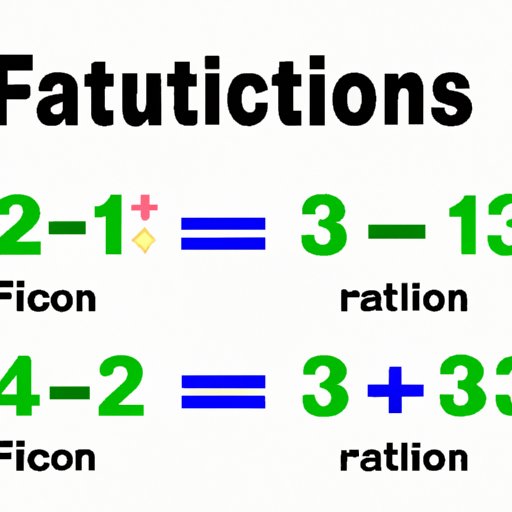
I. Introduction
Adding and subtracting fractions can seem complicated, but with a little bit of practice and the right tools, anyone can master it! In this article, we will go over the basic steps and tips to help simplify the process and help you feel more confident when working with fractions.
II. Step-by-step guide to adding and subtracting fractions
Before we begin, let us make sure we understand the basic concepts of fractions. In a fraction, the top number is called the numerator, and the bottom number is the denominator. The denominator represents the whole unit, while the numerator represents a part of that unit.
A common issue when adding or subtracting fractions is having different denominators. The first step to solving this problem is finding the least common multiple (LCM) of the denominators. This will give us a new denominator that both fractions can be converted to. From there, we can add or subtract the numerators as needed. If the fractions already share a denominator, we simply add or subtract the numerators and keep the common denominator.
III. Visual aids to simplify adding and subtracting fractions
Using visual aids can be incredibly helpful when working with fractions. Diagrams or videos can help illustrate the concept and make it easier to understand. Be sure to use visual aids that are clear and easy to understand. For example, a bar or circle diagram can help show the fraction’s parts in relation to the whole.
IV. Explanation of common denominators
It is important to understand the concept of common denominators when working with fractions. A common denominator is the same denominator shared by two or more fractions. Finding a common denominator is necessary when adding or subtracting fractions with different denominators. To find a common denominator, we must multiply the denominators together.
V. Tips to avoid common mistakes
A common mistake when adding or subtracting fractions is forgetting to find a common denominator. Another mistake is forgetting to simplify the fraction after adding or subtracting. To avoid these mistakes, it is essential to make sure you have found the common denominator and to simplify your answer if possible.
VI. Real-world examples
Understanding fractions is important in everyday life, especially when cooking or measuring. For example, if a recipe calls for 1/3 cup of sugar, and you only have a ¼ cup measuring cup, how much sugar do you need? Being able to add and subtract fractions helps you modify the recipe accurately. Other real-world examples include dividing a pizza or calculating time spent on a task.
VII. Practice problems and quizzes
Practice makes perfect when it comes to working with fractions. Try different examples and solve problems to get comfortable with the process. A good way to test your understanding is to take quizzes to make sure you have a good grasp of the basics.
VIII. Resources for further learning
There are many resources available to help you master fractions. Online classes or courses, textbooks, and video tutorials can all be useful in learning and practicing the skills necessary to succeed in working with fractions.
IX. Conclusion
Adding and subtracting fractions is a skill that is important in everyday life and this article provides the necessary tools and steps to understand and master this concept. Remember to find the common denominator, simplify when possible, and practice often to become more confident in working with fractions. By using the resources and tips provided in this article, anyone can become comfortable with adding and subtracting fractions.





